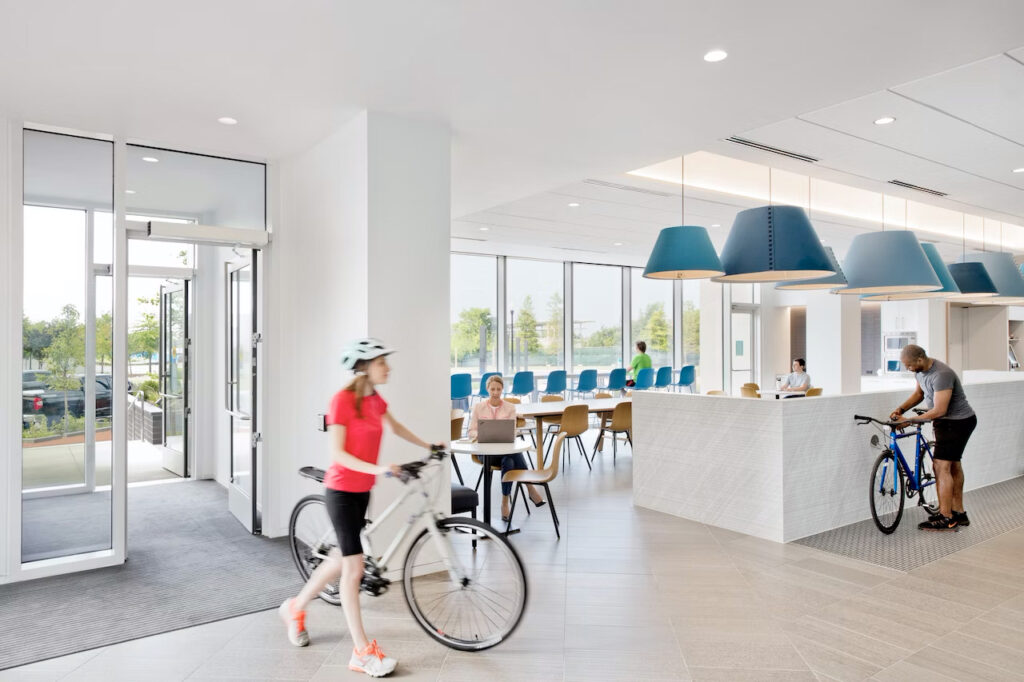6 Eco-Friendly Tips for Your Office
 The need for eco-friendly offices is growing as younger generations move into the workplace. Working on your office sustainability has numerous benefits. You can save on costs, reduce your impact on the environment, attract new talent and improve your company’s reputation.
The need for eco-friendly offices is growing as younger generations move into the workplace. Working on your office sustainability has numerous benefits. You can save on costs, reduce your impact on the environment, attract new talent and improve your company’s reputation.
There are many ways to make your office more eco-friendly, but it can be challenging to know where to start. Below we have highlighted some of the best tips for office sustainability.
1. Go Paperless
Around 50% of the waste a business creates is paper. In the U.S., offices use 12.1 trillion sheets of paper a year, making going paperless one of the best ways to increase your office’s sustainability. Encourage workers to print only necessary documents and use digital methods to share information. Reduce the number of printers in your office by selling them or donating them to local charities. Reducing the number of printers will help limit the temptation to print every document.
There are additional benefits to going digital. You will need less physical storage space for printed files, and the ability to access files from anywhere can make employees more productive.
If you still need to use paper for printing, try to use recycled paper. Find out if there are recycled options for sticky notes, notepads and any other paper your office might need.
A paperless strategy also includes items like paper towels and plates. Look into installing air dryers in your restrooms. Find eco-friendly alternatives to paper towels, such as sugarcane or bamboo towels. Instead of paper towels, you can also use microfiber clothes in your kitchen or pantry. Consider using compostable plates or investing in a few sets of crockery for staff to use. Remember, paper waste is reported to account for 26% of landfill waste.
2. Invest in Reusables
In 2018, landfills in the U.S. received 27 million tons of plastic waste. As one of the largest waste concerns around the world today, investing in reusable options over single-use plastic can significantly impact your office’s sustainability. The initial investment might seem significant but will pay for itself over time.
Consider buying proper cutlery and mugs for the office instead of relying on plastic. Upgrade your water cooler so staff can refill their reusable bottles rather than using plastic cups. Instead of paper towels, get microfiber clothes for your kitchen.
Develop incentive programs that encourage staff to reuse certain items, such as awarding employees who bring their reusable water bottles with tickets to an office-wide raffle. You can reuse files and folders by updating labels. Having your team bring in their reusable water bottles, Tupperware or other things can also reduce plastic use in the office.
Alternatively, invest in supplies that are easy to recycle or compost. Use compostable plates, cups and stirrers. Buy files and binders made with 100% recyclable materials. While not all of these options are reusable, they will help reduce the amount of waste your office creates.
3. Label Trash and Recycling
Knowing what can and cannot be recycled is tricky. Increase office sustainability by putting up memos on notice boards, sending out regular reminders and finding other ways to remind staff about different recyclables. Make sure your bins have clear labels for different types of waste. Have more than one bin for each type of recyclable waste and set them up throughout the office. The easier it is for people to recycle, the more likely they are to do it.
Consider adding a compost bin for compostable goods. Working with a third-party composter in your area makes it easy. They can set up a composting section in your office and regularly take care of any compost.
Remember e-waste! Make sure you responsibly recycle any electronics. Donate or sell any equipment that others can use. Check with your facilities management service if they offer e-waste recycling or if they know of anyone who does. Do some research — there might be electronic recycling programs in your area that could fetch your waste.
4. Manage Lighting and Temperature
Lighting is often overlooked in an office, yet it is essential to energy savings and staff productivity. Take advantage of natural lighting during the day if you have many windows. Natural light has numerous health benefits for your staff and will help lower energy costs.
Use mirrors and light-colored walls to increase the effects of any natural light you get if you have few windows. Switch out bulbs for energy-efficient bulbs. Install motion sensor lights in areas with inconsistent traffic so that lights automatically switch off when no one is around. Motion sensor lights may be beneficial for areas like restrooms, boardrooms, and hallways. Keep only the necessary lights on at night.
Reprogram your office thermostat at least twice a year — at the start of cold and warm weather. Maintaining the same temperature throughout the year can increase your energy usage. The more significant the difference between the inside and outside, the more energy your thermostats use to maintain the temperature.
Open windows during the summer months if you can. Use strategically placed ceiling fans to create a breeze in your office, and switch them off when rooms are empty. Speak to your maintenance team about regular tune-ups for your HVAC system to keep it in top condition. During winter, keep the temperature as low as possible to save energy. Consider other warming methods such as additional insulation, heat glazing on your windows and blocking off areas where cold wind seeps through.
5. Become Power Smart
Most appliances and equipment these days come with built-in energy optimization features. Ramp up energy savings by enabling power-saving and sleep functions on laptops and desktops to help regulate power usage and improve battery life. Switch off or unplug printers, vending machines and other non-essential equipment at night as they pull power even when on “standby.”
An easy way to become power smart is to buy intelligent power strips. Many power strips are designed to save power and come with programmable timers. Set the timer for the average time your office opens and closes. The timer will signal the power strip to turn off for the day.
Some power strips can sense if a room is occupied and will switch off power when a space is empty. When you shut down one appliance, other power strips can sense it and turn off. Smart power strips do all the hard work for you, so no one has to remember which plugs to switch off and when.
6. Make Transport Green
Transport is one of the largest contributors to the U.S. greenhouse gas emissions, accounting for nearly 27% of total emissions. Incentivizing different methods of transportation can lower your office’s overall carbon footprint and increase office sustainability.
There are many eco-friendly alternatives you can encourage your employees to use. Set up a carpooling system where employees in the same neighborhood come to work together to save on emissions and create more substantial relationships. Set aside areas in the parking lot for electric vehicles and bicycles to encourage employees to try new methods of transport. Add a bike rack for people who are using regular bikes. Offer bus or train passes as rewards for meeting specific goals.
In warmer months, try holding biking and walking challenges. Announce prizes for the team or department with the most walking or biking to work each week. Using alternative transport methods is good for the environment and employees’ health.
Design an Office Eco-Friendly With WB Wood
Creating an eco-friendly office requires a cohesive strategy. WB Wood is an experienced furniture project management company that will help you design an eco-friendly office space. Working with our premier manufacturing partner HAWORTH and 300 other manufacturers, we can help you create a welcoming and eco-friendly office space.
Contact our team today to start implementing these eco-friendly office tips!
